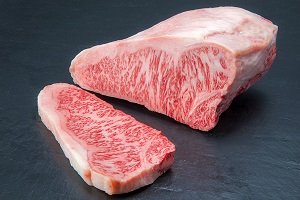Hiba Gyu
| Registration Number | 83 |
|---|---|
| Name of the GI | Hiba Gyu |
| Class | Meat |
| Date of Protection | 2019/09/09 |
| Producing Area | Hiroshima Prefecture |
| Applicant - Name and Address | Azuma-zuru Promotion Association 1-10-1 Nakahonmachi, Shobara City, Hiroshima Prefecture |
Producing Area
Hiba Gyu is beef of Japanese Black (Kuroge Wagyu) from the Iwakura-zuru, which is one of the oldest Tsuru-ushi (1) cow lines produced in Shobara City, Hiroshima Prefecture.
Breeding cattle of Hiba Gyu genetically have a high percentage of unsaturated fatty acids, meaning that Hiba Gyu beef has soft texture and melts in the mouth.
Breeding cattle of Hiba Gyu should be pedigree Japanese Black (Kuroge Wagyu) produced in Shobara City, Hiroshima Prefecture, with a father, maternal grandfather, or maternal grandmother's father as a fertile bull of Hiroshima Prefecture descended from "No. 38-1 Iwata."
Additionally, bullock or heifer beef that meets the following standards may be shipped as Hiba Gyu; ⅰ) the place of the longest fattening period and the last rearing place should be Hiroshima Prefecture; ⅱ) the score of meat quality grade must be above 3 in Beef Carcass Trading Standard set by Japan Meat Grading Association..
Shobara City, as the place of production of Hiba Gyu breeding cattle, is located in a mountainous area in northern Hiroshima Prefecture.
Wagyu cattle have a long history of being closely tied with people's livelihoods in the region, having also played an integral part in farming and tatara steelmaking (2).
In 1843, by breeding particularly excellent cows selected from among Wagyu, the Iwakura-zuru line that continues today was produced. Since then, collective and planned breeding in the region created a unique line, leading to the birth of excellent Kuroge Wagyu.
As a result of these efforts, Hiba Gyu received the Minister of Agriculture, Forestry and Fisheries Award at the third National Wagyu Competition (1977), and successive Prime Minister Awards at the fourth (1982) and fifth (1987). The awards recognized the breeding initiative in the region.
Local efforts geared to securing quality and improving value, including the certification of Hiba Gyu by Shobara City, continue today.
- Tsuru-ushi: Closely related pedigrees of excellent Wagyu that have been bred in the Chugoku region. Breeding began in the late Edo Period, and the strains with superior characteristics in terms of quality, growth, and breeding were traditionally referred to as
- Tatara steelmaking: A traditional Japanese steelmaking technique where iron sand as the raw material and charcoal for reduction are put into a low furnace shaped like a box made from clay, air is supplied, and steel is removed. The technique was brought from the Korean Peninsula in the latter part of the sixth century AD, and was perfected during the mid-Edo Period.


